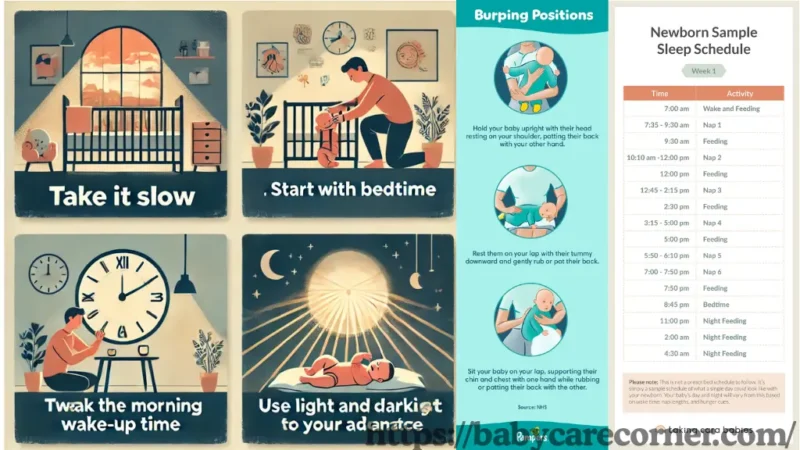How to change baby sleep schedule? It’s a common question for many sleep-deprived parents. Whether you’re dealing with daylight saving time, travel, or a growing baby with shifting sleep needs, adjusting their routine can feel challenging.

The good news? You can successfully change your baby’s sleep schedule with gradual adjustments and a bit of consistency. A few simple steps can make bedtime smoother and wake-ups more predictable.
In this article, we’ll explore easy tips and proven strategies to help you reset your baby’s sleep routine, ensuring restful nights and happy days for both of you. Let’s dive in!
Understanding Your Baby’s Sleep Patterns
First, let’s unravel the mystery of your baby’s sleep. Did you know that babies don’t follow the same sleep cycles as adults? Their internal clocks, called circadian rhythms, take months to develop fully.
- Newborns (0–3 months): They’re like little sleep machines, napping 14–17 hours a day but in short bursts of 2–3 hours.
- Infants (4–11 months): This is when babies start consolidating sleep, often sleeping 10–12 hours at night with 2–3 naps during the day.
- Toddlers (1–2 years): Expect 11–14 hours of total sleep, with 1–2 daytime naps.
The takeaway? Sleep needs to change as your baby grows. Understanding these patterns is the first step to creating a schedule that works for both of you.
When to Adjust Your Baby’s Sleep Schedule?
Now that we know the basics let’s discuss when you might need to tweak things. Babies are creatures of habit, but sometimes life throws a curveball, and their sleep schedule needs a little fine-tuning.
Here are some common reasons:
- Daylight Saving Time: That pesky clock change can mess with bedtime.
- Travel Across Time Zones: Jet lag isn’t just for adults!
- Developmental Milestones: Crawling, walking, or even learning to wave “bye-bye” can disrupt sleep.
- Starting Daycare: A new routine might require a scheduled shift.
- Overtired or Under-tired Baby: If your baby is fussy or wide-eyed at bedtime, their schedule might need tweaking.
What is the best time to adjust a schedule? When your baby is healthy, well-fed, and not in the middle of a significant milestone or illness.
Step-by-Step Guide to Changing Your Baby’s Sleep Schedule:

Ready to make some changes? Let’s break it down step by step so it doesn’t feel overwhelming.
1. Take It Slow
Think of this as adjusting the thermostat, not flipping a switch. Move bedtime or wake-up time by 15 minutes every few days. Small, gradual changes are more accessible for your baby (and you) to handle.
2. Start with Bedtime
Bedtime is the anchor for your baby’s sleep schedule. Want them to wake up earlier? Start putting them to bed a little earlier. Need them to stay up later? Slowly push bedtime back.
3. Adjust Nap Times
Naps are like puzzle pieces in the sleep schedule. Shift nap times to align with the new bedtime. For example, if bedtime moves earlier, so should naps.
4. Tweak the Morning Wake-Up Time
Consistency is key here. Even if your baby wakes up early during the transition, try to keep them in their crib or room until the new wake-up time. This helps set their internal clock.
5. Use Light and Darkness to Your Advantage
Babies are like little sunflowers—they respond to light. Use natural light to signal it’s time to be awake and keep the room dark for sleep.
Tips to Make the Transition Easier
Adjusting a sleep schedule isn’t always smooth sailing, but these tips can help:
- Stick to a Bedtime Routine: A warm bath, a lullaby, and a cozy cuddle can signal bedtime.
- Use White Noise: This can help drown out household sounds and create a consistent sleep environment.
- Offer Comfort Items: A favorite blanket or lovey can make bedtime feel safe and predictable.
- Be Patient. Babies take time to adapt, so don’t worry if things aren’t perfect right away.
Common Challenges and How to Overcome Them
Let’s talk about the hiccups you might encounter and how to tackle them like a pro.
Challenge 1: Night Wakings
Babies often wake up during the night, especially during transitions. Please stick to the new schedule and avoid bringing them into bed (unless co-sleeping is your thing).
Challenge 2: Baby Resists the New Schedule
Resistance is normal. Stay consistent, and remember, you’re the captain of this ship.
Challenge 3: Parent Exhaustion
Take turns with your partner or ask for help. Remember, self-care isn’t selfish—it’s essential.
Do’s and Don’ts for Adjusting Baby’s Sleep Schedule:
Do’s
- Be consistent with bedtime and wake-up time.
- Keep the environment conducive to sleep (dark, quiet, and calm).
- Offer extra cuddles during the transition.
Don’ts
- Don’t expect overnight success—it’s a process.
- Don’t skip naps—they’re crucial for nighttime sleep.
- Don’t stress if things don’t go perfectly. Flexibility is key.
When to Seek Professional Help?
Sometimes, despite your best efforts, sleep remains elusive. When should you call in reinforcements?
- If your baby consistently struggles to fall asleep or stay asleep.
- If sleep disruptions affect their health or development.
- If you’re feeling overwhelmed and need personalized guidance.
Pediatricians and sleep consultants can provide tailored advice to get everyone back on track.
Helpful Video:
Final Thoughts:
Adjusting your baby’s sleep schedule can feel like navigating a winding road, but with a bit of preparation and a lot of love, you’ll get there. Remember, every baby is unique, so trust your instincts and celebrate the small victories along the way.
Do you have a story or tip to share about changing your baby’s sleep schedule? Drop it in the comments—I’d love to hear from you! And hey, if this article helped, share it with a fellow sleep-deprived parent. After all, we’re all in this together.
